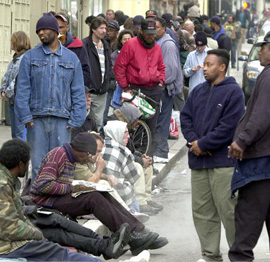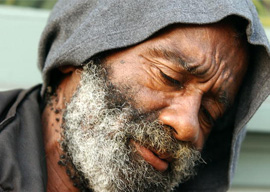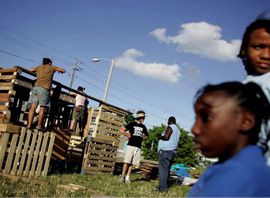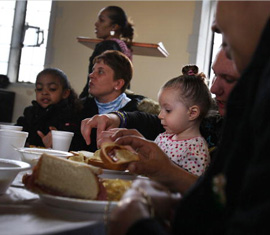
When Lyndon B. Johnson became president after the assassination of John F. Kennedy, he put the power of his presidency behind a remarkable series of reform initiatives. The legislation was geared toward boosting economic opportunity, a theme captured by his administration's catchphrase, the Great Society. "This administration today, here and now, declares unconditional war on poverty in America," he said during his 1964 State of the Union address. But the political drive to eradicate poverty soon faltered on a number of fronts, undone by doubts about the effectiveness of anti-poverty programs and the escalating costs of the Vietnam War. Many initiatives launched more than four decades ago are still in place today. Yet from the heady optimism of the Great Society to the trauma of the Great Recession questions remain about what government should do to help people who are poor. And poverty remains an abiding problem in America. Nearly 40 million Americans or 13.2 percent of the population live in poverty. The poverty rate for children is even higher. And most experts expect poverty rates will go up due to the economic trauma of the Great Recession.


Working Poor
Millions of Americans are among the "working poor." They have jobs, yet earn so little that they live below the poverty line. Even more families are among the "near poor."

Extreme Poverty
Extreme poverty is considered living on an annual income less than half the poverty level. For a typical family of four, that would mean less than about $11,000 a year. Currently, 5.7 percent of Americans live in extreme poverty, and 8.5 percent of children live in extreme poverty.


The Official Poverty Rate
The federal poverty measure deeply affects our understanding of who is poor. And there is a great deal of disagreement about how to properly measure poverty.

Alternative Measures of Poverty
At best, the official measure offers a quick, convenient benchmark. But its flaws are well documented.

The Changing Demographics of Poverty
Who is poor has changed dramatically in the post World War II era. The poverty rate for the elderly declined from 35.2 percent in 1959 to 9.7 percent in 1999, while the poverty rate for children under 6 has risen from 15.3 percent in 1969 to 21.3 percent in 2008.


Aid to Families with Dependent Children
AFDC originally provided monthly support to families with young children. The welfare reform act of 1996 turned AFDC into a workfare program.

Food Stamps
Food stamps were introduced in an experimental program in 1939 as part of the New Deal. The program currently provides about $100 a month for qualifying families. Some 40 million families are expected to take advantage of the program in 2010.

Housing Subsidies
Affordable quality housing remains out of reach for most poor families. The Section 8 voucher programs encourages landlords to rent to low-income families. And tax incentives encourage private developers to build more affordable income units.



Child Care Subsidies
Child care subsidies are federally funded and state administered, but demand is greater than the supply. That's especially true now that strapped state and local governments are spending less on programs geared toward low-income families. Many states have long waiting lists for help.

Medicaid
The federal government partners with the states to provide health care to certain individuals. But contrary to popular belief, a low income isn't enough to qualify for Medicaid, so many individuals in poverty don't qualify for the program.



Head Start
Head Start's annual budget now tops $8 billion and is currently focused on improving accountability and teacher quality. Head Start enrolls about a million children a year at a cost of about $7500 per child.

College Loans
Federal Stafford loans originated in the Higher Education Act of 1965. The government subsidizes these low-interest loans for low-income students. Stafford loans became available to all students after 1978.


Work-Study
The Federal Work-Study Program began in 1964 to help low-income students pay for higher education through campus jobs. It now includes community service so that students may work for local non-profit agencies to help pay tuition. Originally housed in the Department of Labor, the Federal Work-Study Program now belongs to the Education Department and helps more than 650,000 students with annual grants that average about $1500.

College Grants
The Pell Grant is the federal government's mainstay financial support for helping low-income students pay for college. The maximum grant for 2011 is $5,550 and the average grant is about $2,200. The program was authorized in 1972 as the Basic Education Opportunity Grant. It was renamed for its legislative sponsor, the late Senator Claiborne Pell, in 1980.


Office Of Economic Opportunity
The OEO's programs were designed to open up opportunities for poor people as opposed to transferring money to them. Although the agency was dismantled in 1974, its programs were moved to other federal agencies. A majority of those programs still exist.

VISTA
Volunteers In Service To America set middle-class volunteers working side-by-side with low-income recruits from local communities. It is now called AmeriCorps VISTA and it focuses on fighting poverty in America.

Job Corps
Job Corps is the nation's largest and oldest vocational education program for poor young adults. Sixty thousand disadvantaged students learn job and career skills each year at 123 campuses across the country. Students can also earn a high school equivalency diploma and take classes on how to live independently.



Earned Income Tax Credit
The EITC is the nation's most successful and largest anti-poverty program for working families, lifting an estimated 4 million people a year out of poverty. In 2010, low-income families with three or more children can get a credit of up to $5,666.

Welfare Reform
The welfare reform act of 1996 requires anyone receiving cash assistance to work or be training for work. It also restricts recipients to a five-year lifetime limit on federal cash benefits. Welfare rolls declined by 60 percent in the years after the law was passed.



The Moynihan Report
The 1965 report by Assistant Secretary of Labor Daniel Patrick Moynihan warned of a brewing crisis in race relations. Moynihan's detailed study urged national leaders to help stabilize black families by addressing drug abuse, steep unemployment, surging teenage pregnancy rates, and a disturbing achievement gap in education.


The Other America
Published in 1962 by activist scholar Michael Harrington, the book showed how millions of Americans, including half the nation's elderly, lived in poverty despite rising affluence across the country.

Losing Ground
In this book, conservative scholar Charles Murray took a look at poverty policies from 1950 to 1980. He concluded that government welfare programs mostly hurt poor people instead of helping them.

The Truly Disadvantaged
The scholar William Julius Wilson blamed poverty on changes in the economy, including the demise of manufacturing in central cities and the rise of service sector and information technology jobs. His 1990 book documented the ways that poorly educated inner-city residents weren't qualified for good jobs in the new economy, a problem compounded by high dropout rates.


Civil Rights Laws
The Civil Rights Act of 1964 banned discrimination on the basis of race and sex in employment, education and housing. The Fair Housing Act of 1968 gave the federal government the ability to enforce nondiscrimination laws.

Community Action
Major funding for Great Society programs came through Community Action Programs. Congress bypassed state and local governments and provided direct funding to community groups throughout the country.

Model Cities
This program lasted from 1966 to 1974. The basic idea was to reduce urban violence by empowering community leaders to make decisions about federal spending. However, Model Cities ended up creating neighborhoods with high levels of concentrated poverty, unemployment, and crime.



New Federalism
By the time Ronald Reagan was elected president in 1980, the notion of a "war" on poverty had fallen into deep disfavor among the public and legislators. Rather than a federally mandated war, the new thinking was that states should be given greater power to address poverty.




























